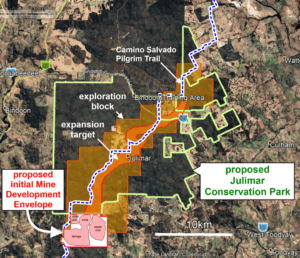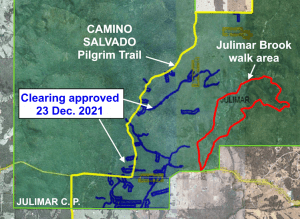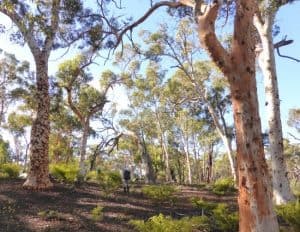A “spectacular” nickel-copper-palladium discovery in early 2020 highlighted the ever-precarious future of our unprotected forests. The Gonneville discovery, located immediately south of the proposed Julimar Conservation Park (the ‘Park’), high-graded an exploration prospect, the ‘Julimar Complex’, 26km long and 7km wide, extending to the northeast across the Park. The prospect lies within a 160 sq km mining lease, capturing more than 40% of the 286 sq km park area.

Following initial exploration in 2019-2020, the miner Chalice Gold Mines Ltd has claimed that the Gonneville polymetallic deposit is estimated to be the largest discovery of its type worldwide since 2000. The EPA has subsequently announced the company’s plans to develop the Gonneville Project and has given the public a deadline of 14th April 2024 to comment. (Read more.)
HikeWest will be recommending that the Gonneville Project proposal be assessed at the Public Environmental Review level of assessment. The miner’s engagement with community stakeholders has to date been limited narrowly to local communities and traditional owners, bypassing the much wider public interest and concern with the environmental implications of the proposed operations. The proposed Mine Development Envelope is bounded by the Park to the north and by the Moondyne Nature Reserve to the south.
Chalice has announced that the Gonneville ore body is likely to extend at least 10km into the Park. An initial permit for clearing work for exploratory drilling within the Park was approved by DWER in December 2021 (see map below). Drilling within the Park began in 2022. By March 2023 100 exploratory holes had so far been drilled. In late 2023 the State Government approved the miner’s plan to proceed with further exploration drilling along the entire prospective 30km fairway across the Park. Updates on the project can be found on the miner’s Julimar Project page.
The miner’s reports so far indicate potential for target zones at Julimar from near surface down to ~850m depth. If exploration results prove successful, future mining might be a combination of open-pit and underground. WA’s massive Mount Keith nickel mine near Wiluna is to date the largest open-cut nickel mine in the world, 300m deep. No ‘world’s best-practice’ environmental solution can hope to adequately rehabilitate the environment once such mining is over. Mining at Julimar would also result in major loss of forest and woodlands. Ironically, those attempting to justify such forest clearing argue that it is a necessary cost of the “desperate” drive for extraction of metals to decarbonise the world in the name of climate change mitigation.
 Julimar Conservation Park (gazetted as Julimar State Forest), northwest of Toodyay, is well known to many bushwalkers for the beauty of its wandoo woodlands. Julimar Brook runs through the southeastern area of the exploration block and the route of the Camino Salvado Pilgrim Trail through the area happens to coincide with most of the prospect (see map). The park also plays a key role in DBCA-Parks & Wildlife Service’s ‘Western Shield’ wildlife recovery program and currently hosts one of the healthiest known chuditch populations in WA. Under the Chuditch National Recovery Plan (WA Wildlife Management Program #54, DEC) 2012, “Actions that remove native vegetation (e.g. increased fire frequency, clearing for development, mineral exploration and extraction, forestry) can result in a significant impact on the chuditch, particularly if these actions remove habitat critical for survival, or occur within 15 km of habitat critical to survival.”
Julimar Conservation Park (gazetted as Julimar State Forest), northwest of Toodyay, is well known to many bushwalkers for the beauty of its wandoo woodlands. Julimar Brook runs through the southeastern area of the exploration block and the route of the Camino Salvado Pilgrim Trail through the area happens to coincide with most of the prospect (see map). The park also plays a key role in DBCA-Parks & Wildlife Service’s ‘Western Shield’ wildlife recovery program and currently hosts one of the healthiest known chuditch populations in WA. Under the Chuditch National Recovery Plan (WA Wildlife Management Program #54, DEC) 2012, “Actions that remove native vegetation (e.g. increased fire frequency, clearing for development, mineral exploration and extraction, forestry) can result in a significant impact on the chuditch, particularly if these actions remove habitat critical for survival, or occur within 15 km of habitat critical to survival.”
Like national parks, conservation parks and nature reserves are set aside under the Forest Management Plan and listed under the National Reserve System to protect biodiversity and natural and cultural features. They are generally smaller than the national parks and do not have the same level of protection from competing land uses. They are especially vulnerable in WA to the encroachment of mining exploration and extraction which is approved and governed by separate legislation and processes.
 Examples of other conservation parks and reserves, that are familiar to many bushwalkers, and have been – or in the future will be – heavily impacted by mining include: Gyngoorda CP, Gibbs CP and Lane Poole Reserve. Gyngoorda CP previously covered the entire Bannister Hill area near Albany Highway, but was subsequently reduced by more than 60% in the Forest Management Plan so as to accommodate future bauxite mining plans. The Gibbs CP, eastern Darling Range, previously covered an area of the upper Dale River catchment, but was subsequently also reduced by more than 60% to accommodate future bauxite mining plans. Lane Poole Reserve, south of Dwellingup has also been ‘adjusted’ to accommodate the current expansion of the Willowdale bauxite mining operations.
Examples of other conservation parks and reserves, that are familiar to many bushwalkers, and have been – or in the future will be – heavily impacted by mining include: Gyngoorda CP, Gibbs CP and Lane Poole Reserve. Gyngoorda CP previously covered the entire Bannister Hill area near Albany Highway, but was subsequently reduced by more than 60% in the Forest Management Plan so as to accommodate future bauxite mining plans. The Gibbs CP, eastern Darling Range, previously covered an area of the upper Dale River catchment, but was subsequently also reduced by more than 60% to accommodate future bauxite mining plans. Lane Poole Reserve, south of Dwellingup has also been ‘adjusted’ to accommodate the current expansion of the Willowdale bauxite mining operations.
The Julimar Conservation and Forest Alliance is campaigning to have the proposed Julimar Conservation Park (currently State Forest) declared a National Park.
Additional Reading
- Gonneville Nickel-Copper-Platinum Group Element (PGE) Project, Environmental Protection Authority (WA), April 2024.
- Progress in protecting WA’s forests – Fact or fiction?, HikeWest post, March 2024.
- Julimar Conservation and Forest Alliance, website.
- Julimar Nickel-Copper-PGE Exploration Project, Chalice Mining.
- “Will WA have to lose forests to fuel a renewable energy future?”, Peter de Kruijff, article in WAtoday, 9 June 2022.
Original post 9 April 2020. Most recent update: 9 April 2024.
View more news updates